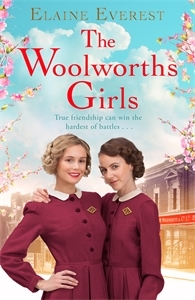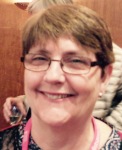Today we welcome back author and former Write Minds contributor, Elaine Everest, whose novel The Woolworths Girls, was published on 5th May
 Thank you for inviting me to your blog!
Thank you for inviting me to your blog!
It’s lovely to have you back! Your novel is set in Erith, which you obviously know well as you grew up there. How did you find out what it looked like during the war years? Had the shops and street plan changed much?
My memories of the Erith from my childhood in the late fifties and sixties are very similar to the Erith of 1938 when The Woolworths Girls starts. Some buildings had been demolished but it was in 1966 that the local council started to knock down all the lovely old buildings in Pier Road and the High Street that formed the major shopping area of the town. Beautiful Victorian town houses that lined the railway line also disappeared as did a church and smaller homes. The street where I lived when first married is one of the only remaining complete streets from ‘the old days’ and is where Sarah and her Nan, Ruby, live.
It amused me at the time to see a sign declaring that the company ‘Sid Bishop’ was demolishing the church although much later we were sad to see the old town vanish and be replaced by a horrid concrete jungle. This has now been replaced and looks no different to shopping malls throughout the country.
We can tell you did a lot of other research for your novel. Were you in danger of getting caught up in it? Do you have any advice for others needing to do research?
I’m always in danger of getting caught up in what to me is local history. But, I went in with a list and tried to find only information that I needed for my story. If I can advise other writers I would stick to your research list. Then I started to browse local news reports and found stories that I knew my girls would have become involved in…
I was also fortunate to make contact with the curator of the Woolworths museum, Mr Paul Seaton, who delved into his archives and found some interesting information about the Erith branch of Woolies that again my girls could be part of. I loved the story of the branch taking part in the local cottage hospital fete and one of my girls was the carnival queen while another moaned about playing a part in the proceedings. I’ll leave you to guess who!
Some of your secondary characters clearly have their own stories to tell. Are there books in the pipeline for any of them?
I loved inventing my secondary characters as much as my main characters. In some ways they are able to be a little more naughty than the main cast. Ruby, Sarah’s nan, along with her friend, Vera from up the road, appear in a short story in the My Weekly magazine. This should be published in the next few weeks. It was fun to write about their antics early in 1938 before Sarah moved to Erith and The Woolworths Girls began. Freda pops up in my next novel, The Butlins Girls (Pan Macmillan ,2017) and she does mention her friends Sarah and Maisie. As this novel is set in 1946 we get to hear more about my girls from Woolies.
I would love to write another novel about Sarah, Maisie and Freda and how they lived through the rest of the war years. I’m sure I could get them into all kinds of trouble and add some romance at the same time.
Which of the characters in The Woolworths Girls was your favourite, and why?
I’ve been asked this question before and each time I’ve chosen a different character. The problem is I like so many of them. This time I will say Betty Billington who was the staff manager who hired Sarah and her chums. As the war progressed she takes over as temporary manager and her life becomes entwined with Sarah’s – in fact Betty is another Woolworths girl. Being older her life suffered during the Great War and I would really like to go back and investigate her life more. Hmm I seem to be thinking of even more books to write!
Were any of the characters based on real people?
Not really but… I have a cousin who confessed to me that he had always wanted to play a baddie. This surprised me as he is such an upright citizen. So, I gave him a small part in the story and changed his name slightly. I wonder he will recognize himself?
Also, Charlie, who was Betty’s lost love is based on my great uncle Charles who died at Ypres on 17th August 1917. Although he came from a large family and died at the age of 32 he had no children or spouse. In mentioning him in The Woolworths Girls I feel I’ve kept his memory alive.
Have you always wanted to write sagas?
Part of me always wanted to be a saga writer as I really like the genre. However, like many writers I have a few novels tucked away that will probably never see the light of day. Mine are a romcom that did place me as a finalist in The Harry Bowling prize and also crime novels set in my favourite dog showing world. However, sagas won and I’m more than delighted to be able to write them.
We know a lot of hard work goes into writing a novel. How do you organise yourself to achieve it?
Plan, Plan, Plan! I like to have timelines in place. For The Woolworths Girls this was not only my fictional timeline but also local history and world events. I also had a timeline of Woolworths events and how they progressed through the world while it was at war. During my research I got to know my main characters and fleshed them out. Story outline was turned into a basic chapter breakdown – then I started to write.
Thank you, Elaine. We’ve both read The Woolworths Girls and thoroughly enjoyed it. The very best of luck with it.
 It’s 1938 and as the threat of war hangs over the country, Sarah Caselton is preparing for her new job at Woolworths. Before long, she forms a tight bond with two of her colleagues: the glamorous Maisie and shy Freda. The trio couldn’t be more different, but they immediately form a close-knit friendship, sharing their hopes and dreams for the future.
It’s 1938 and as the threat of war hangs over the country, Sarah Caselton is preparing for her new job at Woolworths. Before long, she forms a tight bond with two of her colleagues: the glamorous Maisie and shy Freda. The trio couldn’t be more different, but they immediately form a close-knit friendship, sharing their hopes and dreams for the future.
Sarah soon falls into the rhythm of her new position, enjoying the social events hosted by Woolies and her blossoming romance with young assistant manager, Alan. But with the threat of war clouding the horizon, the young men and women of Woolworths realize that there are bigger battles ahead. It’s a dangerous time for the nation, and an even more perilous time to fall in love…
Elaine’s book, published by Pan Macmillan, is available on Amazon
About Elaine
Elaine Everest was born and brought up in North West Kent, where The Woolworths Girls is set, and was once a Woolworths girl herself.
Elaine has written widely for women’s magazines, with both short stories and features. When she isn’t writing, Elaine runs The Write Place creative writing school in Dartford, Kent, and the blog for the Romantic Novelists’ Association.
Elaine lives with her husband, Michael, and their Polish Lowland Sheepdog, Henry, in Swanley, Kent.
Links:
Pan Macmillan page
Facebook Author page
Twitter: @ElaineEverest












 Thank you for inviting me to your blog!
Thank you for inviting me to your blog! It’s 1938 and as the threat of war hangs over the country, Sarah Caselton is preparing for her new job at Woolworths. Before long, she forms a tight bond with two of her colleagues: the glamorous Maisie and shy Freda. The trio couldn’t be more different, but they immediately form a close-knit friendship, sharing their hopes and dreams for the future.
It’s 1938 and as the threat of war hangs over the country, Sarah Caselton is preparing for her new job at Woolworths. Before long, she forms a tight bond with two of her colleagues: the glamorous Maisie and shy Freda. The trio couldn’t be more different, but they immediately form a close-knit friendship, sharing their hopes and dreams for the future.